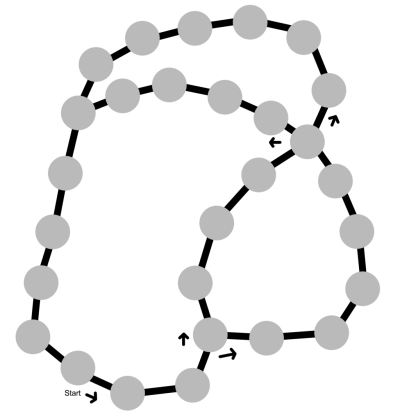Troubling Travels
Troubling Travels is a gambling game that is popular among caravan traders. It can have anywhere between 2-5 players, though sometimes people attempt to play with more. Generally, though, if there are 6 or more players, people prefer to play multiple smaller games.
It was originally developed by the dassen people, who had nothing better to do with the gold coins they would inevitably receive when trading with other sentients, and so simply used the coins as game pieces.
Since its original development Trouble Travels has become the most popular gambling game on the planet. It is often played at parties, and is credited as the reason for a lot of arguments and falling-outs among friends.
Game Pieces
The game is played using gold coins as the pieces, dice, tiles, and points system. It also has a deck of event cards (which are usually just quickly-scrawled notes on torn up paper).
The coins are broken up into these categories:
• Player’s Pieces: Each player uses a gold coin as their playing piece. They will often mark these coins before playing, which means currency used for the game can be quite filthy.
• Movement Coins: These coins are used to roll the amount a player will move each turn. The amount of movement coins varies depending on the number of players, as each contributes 1 coin to the pot.
• Score Pot: The score pot is the prize for the game. Everyone contributes a set amount to the prize pot before the game, and that amount becomes the winning score. When a point is earned in the game, a coin is taken from the score pot and put into the player’s accumulated coins. Once the winning score is collected by a player, the game ends.
• Tiles: Each player will contribute 5-15 coins that are placed down together to form the path that the player’s pieces will travel along. These coins are all put on the same side (either all heads or all tails) during setup.
The event card decks can either be purchased from a store or made by the players before the game. Event cards are generally things that affect the coin pot, such as “Sold bread, +2 gold” or “Bandits attack! -4 gold.” There are also cards that affect the player’s position or turn such as “strong winds, move back 3 spaces” or “wheel broken, lose a turn.”
Sometimes, the wealthy will have pre-made boards consisting of materials such as cardboard, marble, or wood. Some expensive boards have tiles that spin to mark their activation status and beautifully detailed painted backgrounds, but most people people prefer the randomness of scattering coins to work as randomly-generated tiles.

Setting up the game
The game is relatively easy to set up. Coins are simply laid out in the middle of a table to create the board, and then to the side are placed the score pot, movement coin cup, and the shuffled event card deck.
Before the game starts players will each flip a coin at the same time. Any whose coins land on heads will repeat the coin flip until only one player is left. This player is the first to move on the board, and turn order is then taken in a clockwise direction around the table. Generally, the coins flipped to decide the turn order will become the movement coins.
Once the turn order is decided, the player will put all of the movement coins into the coin cup, shake the cup, and tip the coins onto the table. Counting the number of heads will determine the number of spaces they move along the board. If a 0 is rolled, this counts as if they moved onto the spot they were already on and the tile will activate its effect.
Every time a player lands on a space, the space will activate and then change its activation status; which is represented by flipping the coin over. Activation statuses are “gain”, “lose”, and “event”, and will change in that order, resetting to gain on the third activation.
Activation effects are as listed:
• Gain: The starting status of all coins on the board. Every time a player lands on a gain space they will take 2 coins from the score pot, and flip the coin over to its other side to set it to the “lose” status.
• Lose: When a player lands on the lose symbol, they will return 1 coin to the coin pot. They will then take a card from the event deck and place it on top of the lose tile. This changes the space to an event tile.
• Event: After landing on an event tile, the player will take the card from the space and read it’s effect out loud to the group. The card’s event takes effect, the card is discarded, and the coin is turned back to its original side and becomes a “gain” space again.
The first player to collect the winning score gets to keep the money they have collected, the money that is left in the score pot, and the coins that make up the board tiles. The other players get to keep the money they accumulated during the game, so though they are at a loss after the game ends, they do not always lose the entire amount that they contributed to the pile.
Although it is not required, it is considered good sportsmanship in the Rendi for movement coins to remain with their players after a game. However, in Eala cultures is it considered rude for the winner to not take the movement coins, as it is seen as a form of bragging.